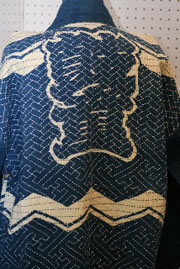


Kodo staff member Kiyoko Oi's embroidered Kodo hanten (traditional Japanese coats) will be featured in the first major British exhibition of Japanese Sashiko Textiles being launched at York Art Gallery in October 2009. The show and subsequent UK tour will present traditional and contemporary textiles and garments, designed to decorate and protect the wearer both physically and spiritually. Entitled "Japanese Sashiko Textiles," this exhibition sets out to portray a sense of time and place in which these works were created.
The exhibition has been curated by textile artist Michele Walker who says: "The objects have been chosen for the stories they tell. My research is taking place at a critical time when the last generation of (now elderly) makers is rapidly drawing to a close together with their traditional way of life and the disappearance of the natural landscape to which they belong."
The exhibition starts in York, and will spend a year in the UK, with showings in Glasgow and Plymouth on the agenda.
Kiyoko Oi joined 'Sado no Kuni Ondekoza' in 1975 as a performing member. She was among the first Kodo members to get married and raise children under the Kodo roof. Throughout it all she has continued to make quilts and built a reputation as one of Japan's premiere female marathon runners. She still runs to this day.
In the Kodo office, Kiyoko currently facilitates the 'Friends of Kodo' program and is involved in making stage costumes. She also leads farming activities, forest maintenance, gardening, cooking for our village festival and mochi pounding for the New Year. In many ways Kiyoko is the 'Mother of Kodo Village.'
Kiyoko was first inspired by quilt work she saw at the Ogi Folklore Museum in Shukunegi on Sado about thirty years ago. On Sado there is a thick thermal wear called "Zonza," similar to the "Donja" wear seen in Hokkaido and Aomori and "Donda" wear in Oita, which was essential for maritime workers to protect them from the cold and tide. Using old cloths and patch scraps, quilting requires much patience to complete lasting wear. Since Kiyoko first encountered quilting on Sado, she has continued to create numerous pieces as her life's work. She takes time to come up with the best pattern for the cloth and stitches various patterns, both traditional and contemporary.